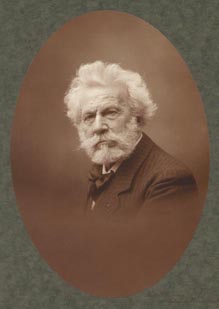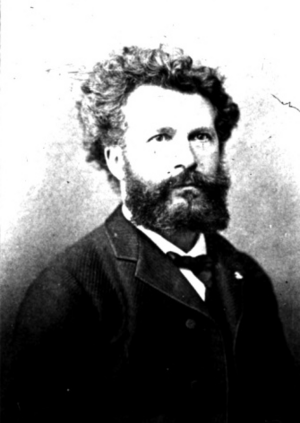Camille Flammarion facts for kids
Quick facts for kids
Camille Flammarion
|
|
|---|---|
 |
|
| Born |
Nicolas Camille Flammarion
26 February 1842 Montigny-le-Roi, France
|
| Died | 3 June 1925 (aged 83) Juvisy-sur-Orge, France
|
| Spouse(s) |
|
| Relatives | Ernest Flammarion (brother) |
Nicolas Camille Flammarion (born February 26, 1842 – died June 3, 1925) was a famous French astronomer and writer. He wrote over fifty books, including popular science books about space, exciting early science fiction novels, and works about mysterious topics like mind powers. He also started a magazine called L'Astronomie in 1882. Camille Flammarion had his own private observatory in Juvisy-sur-Orge, France.
Contents
About Camille Flammarion
Camille Flammarion was born in Montigny-le-Roi, France. His brother, Ernest Flammarion, later started a big publishing company. In 1858, Camille began working at the Paris Observatory. He was one of the people who started the Société astronomique de France, which is a French astronomy society. He was also its first president. This society had its own journal, but later it joined with Flammarion's magazine, L’Astronomie.
A famous picture called the "Flammarion engraving" first appeared in his 1888 book L’Atmosphère. Camille Flammarion had many interesting ideas. In 1907, he thought that people on Mars might have tried to talk to Earth. He also worried that a comet heading towards Earth in 1910, Halley's Comet, might change our planet's air.
As a young man, Flammarion was interested in new ideas about how life changes over time, from scientists like Charles Darwin. He was also curious about spiritism, which is the belief that spirits of the dead can communicate with the living. People described him as an "astronomer, mystic, and storyteller" who was very interested in life after death and life on other planets. He saw these ideas as connected.
He believed that after people die, their souls might travel from one planet to another, becoming better with each new life. In 1862, he wrote his first book, The Plurality of Inhabited Worlds. Soon after, he left his job at the Paris Observatory.
In his books like Real and Imaginary Worlds (1864) and Lumen (1887), he wrote about many strange creatures, even plants that could digest and breathe at the same time. He strongly believed in extraterrestrial life (life beyond Earth). He thought that humans are "citizens of the sky" and that other worlds are like "schools" where souls learn and grow.
His studies of mysterious mind powers also influenced his science fiction. He wrote about souls traveling through the universe and being reborn on different planets. In his book Lumen, a character meets an alien soul that has lived on many different worlds, each with its own unique life forms. His ideas about other worlds often matched the scientific theories of his time about how planets develop.
Flammarion's mix of science, science fiction, and spiritual ideas was very popular. He helped spread the idea that advanced alien species live on many planets and that human souls evolve through cosmic reincarnation. His ideas influenced later writers, including Olaf Stapledon, William Hope Hodgson, and Arthur Conan Doyle. For example, Doyle's book The Poison Belt (1913) shared some of Flammarion's worries about comets.
Camille Flammarion's Family
Camille had a brother named Ernest Flammarion and a sister named Berthe Martin-Flammarion. His first wife was Sylvie Petiaux-Hugo Flammarion. His second wife was Gabrielle Renaudot Flammarion, who was also a well-known astronomer.
His Ideas About Mars
In the late 1800s, astronomers like Giovanni Schiaparelli thought they saw lines on the surface of Mars. They called these "canals." Later, better telescopes showed that these lines were actually an optical illusion. However, Camille Flammarion studied these "canals" a lot in the 1880s and 1890s.
Like another astronomer, Percival Lowell, Flammarion believed these "canals" were built by intelligent beings. He thought they were like old rivers that had been fixed to help spread water across the planet. He imagined that Mars was a very old planet, and its intelligent inhabitants were trying to survive on a dying world by building these canals.
His Research into Psychic Phenomena
Camille Flammarion studied spiritism and other mysterious topics like reincarnation using a scientific approach. He wrote that we should always use science to find the truth and be careful not to let beliefs get in the way. He was close to Allan Kardec, who started the Spiritism movement.
Flammarion investigated people who claimed to talk to spirits, called mediums. He found that many mediums often cheated. However, he also believed that some strange events might be real. He thought that some unexplained things could be caused by an unknown "psychic force" from the medium, rather than spirits. He also believed that telepathy, or mind-to-mind communication, could explain some unusual events.
After studying "automatic writing" (where someone writes without consciously controlling it), he thought it was caused by the subconscious mind, not spirits. He believed that the soul survives after death, but he didn't think that mediums had scientifically proven communication with spirits.
In his later years, Flammarion changed some of his ideas about ghosts and hauntings. In his 1924 book Haunted Houses, he suggested that some hauntings might be caused by departed souls, while others could be from the "remote action of the psychic force of a living person."
After 60 years of studying mysterious events, Flammarion said he believed in telepathy, and that sometimes, though rarely, the dead do appear in haunted places. He was also a member of the Theosophical Society, which explores spiritual wisdom.
Camille Flammarion's Legacy
Camille Flammarion was the first person to suggest the names Triton for a moon of Neptune and Amalthea for a moon of Jupiter. These names were officially used many years later. Famous scientist George Gamow said that Flammarion's work greatly influenced his own interest in science when he was a child.
Honors and Recognition
Many things have been named after Camille Flammarion:
- A crater on the Moon
- A crater on Mars
- The Asteroid 1021 Flammario is named in his honor. Other asteroids are named after his sister, his books, and his observatory.
- In 1897, he received the Prix Jules Janssen, which is the highest award from the French astronomical society.
- He was given the high French honor of Commandeur de la Legion d'honneur.
His Important Books
- The Plurality of Inhabited Worlds (1862)
- Real and Imaginary Worlds (1865)
- Popular Astronomy (1880) - This was his most popular book.
- The End of the World (1893) - A science fiction novel about a comet hitting Earth. It was later made into a film.
- The Unknown (1900) - A collection of stories about psychic experiences.
- Dreams of an Astronomer (1923)
- Haunted Houses (1924)
See also
 In Spanish: Camille Flammarion para niños
In Spanish: Camille Flammarion para niños
- Flammarion engraving




